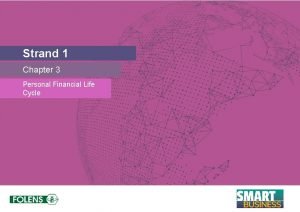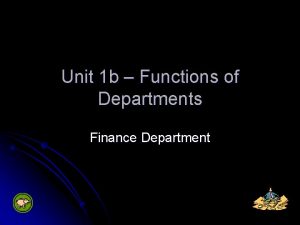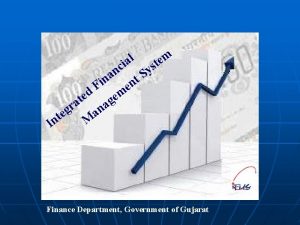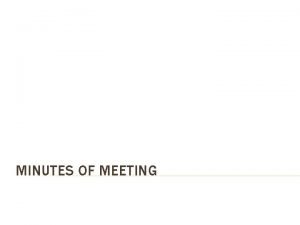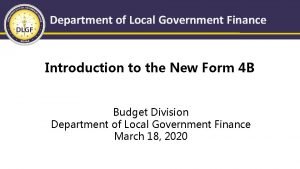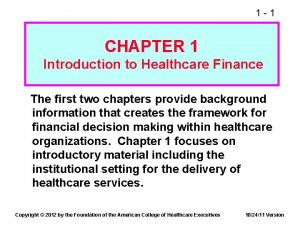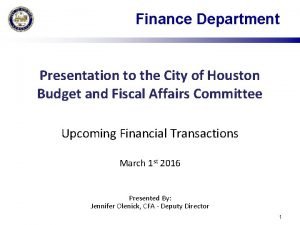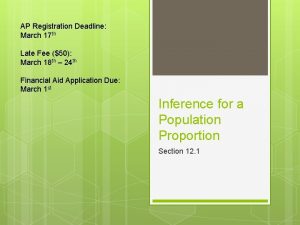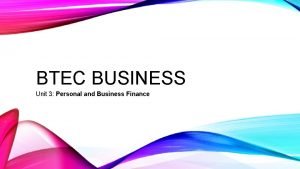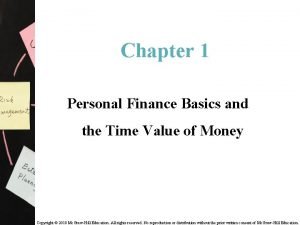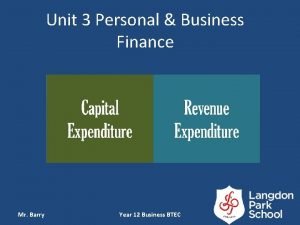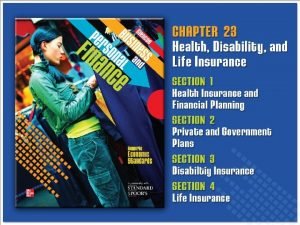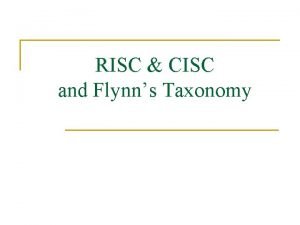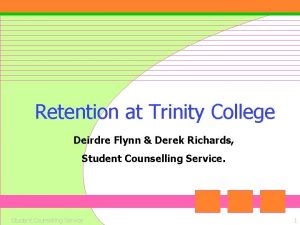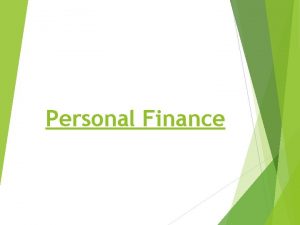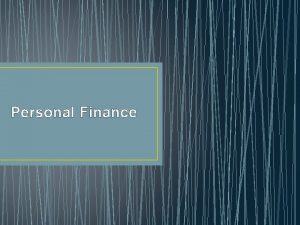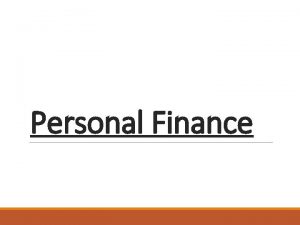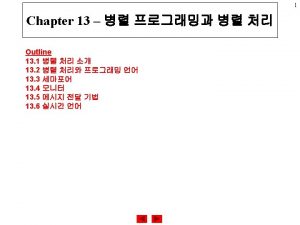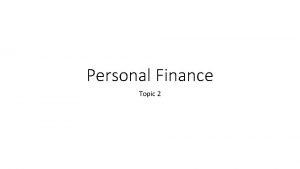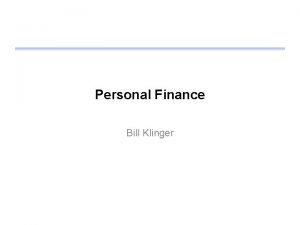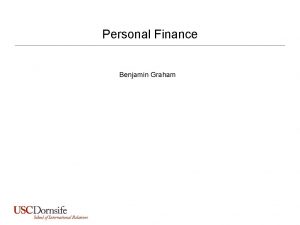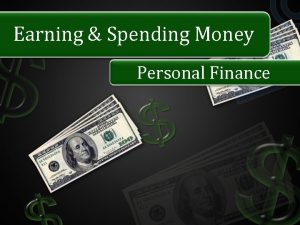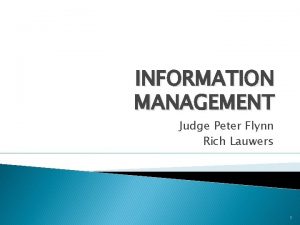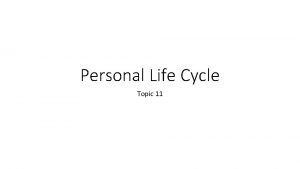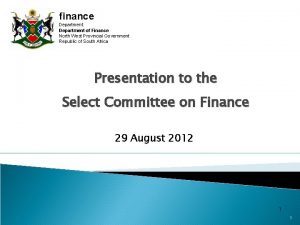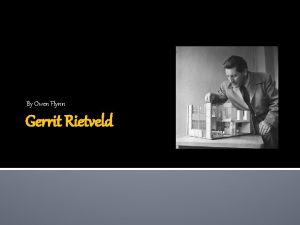Finance and Personal Life Peter Flynn Department of




















- Slides: 20

Finance and Personal Life Peter Flynn Department of Mechanical Engineering University of Alberta

Some Questions What is my income profile, and how long do I work? How long a retirement period do I need to finance, and how much? How much can I earn on my savings? From all this we will calculate how much of my income do I need to save if not in a retirement plan. 2

The Disclaimer I am not: n A Certified Financial Planner I have not: n Made my living by investing other people’s money. I will not: n Recommend any investment. I have thought a lot about personal finance and its impact on life. 3

First Advice Be young when you are young, and so forth. Think of values other than money on key purchasing decisions: n n Buy a painting because you like it, as you will likely be dead when it is sold. Buy (or don’t buy) a house for family values. 4

Why Do We Save? We live a long time past 60 or 65, on average. We may live even longer individually. n “I planned to live to 80, and there is no end in sight. ” We mistrust the social safety net. We don’t know how much intergenerational transfer will occur. 5

Some Subtleties Keep in mind: n Inflation n Pre or post tax An RRSP defers tax on income, but what is there is eventually taxed as income. 6

Can it really be 18%? How do company and government pension plans survive on less? Is flat real income the right planning goal? 7

Getting 4% Over Inflation? ? Long term Canada Bonds: n 4. 9% (<3% over inflation, and locked in). Inflation protected Canada Bonds: n 2. 35% (return is low but protected). GIC’s and shorter term bonds: Shorter term, even lower return (yield curve). “Safe” company bonds return ~3 -5%. Safety has the price of a low return. 8

Traditional Advice is Questionable Have “your age” in fixed income (bonds), i. e. : n n At 35, 35% At 65, 65%. This advice is conservative and reflects an era when people died earlier. 9

Equity vs. Fixed Income Risk and return transfers to equity. n n An initial investor in Dell made 40, 000% return in ~10 years. The lender to Dell made 6% per year. An investor in Nortel at the peak lost 99. 5% of their value. The lender to Nortel made 6% per year. On long term (!) average, equity is 2% or more higher return than debt. 10

Very Long Term Returns For the period 1926 to 2005 (80 years): n Inflation (CPI) was 3. 1% Long term bonds returned 6. 2% Canadian common stocks returned 9. 99% n Return is average annual compound rate n n 11

Tax Issues: Interest taxed as income. Dividends taxed at a lower rate. Capital gains taxed (now) at ½ the rate of income. But, in an RRSP, all withdrawals are taxed as income. All gains are sheltered until withdrawn, then treated equally. 12

What to Pick? Two emotions on Bay Street: greed and fear. Different styles: n n n Value Growth Speculative Diversification: lower return from broader holding. 13

Thinking about Equities Signs of value: n n n Low price earnings ratio. Steady (growth in? ) earnings. Reasonable dividend yield. Signs of growth: n n n Typically low dividend yield. Low PEG ratio. High growth in sales and earnings. 14

Traditional Advice is Questionable Is a mutual fund a good way to diversify? n n n MER (regardless of success) has become a large percentage of shrinking yields. About 3 out of ten outperform a broad index (ditto for brokers); in 2008 6 out of ten fell more than index funds. Hence index funds (ETF) have become increasingly popular. 15

Commodities are Very Risky 98% of commodity traders lose money: sheep are being sheared by wolves. “If you are really good at trading commodities, it will take you a long time to lose all your money. ” One possible exception: you have detailed knowledge of a commodity, and the discipline to get and stay out. 16

Some Personal Thoughts Life is best lived in balance…be young… A “portfolio” has a mix, from value to growth to risk. Shift the mix as you get older, because you run out of time to make up losses. Understand your own tolerance of risk: can you lose, and how much, and still have a sense of contentment? 17

Some Personal Thoughts (2) If it seems to good to be true, it likely is (e. g. Enron). If the cab driver discusses a stock, sell immediately. Many are closer to the street than you. You have the advantage of time. A professional is measured quarter by quarter, you won’t retire for 20 -40 years. 18

Some Personal Thoughts (3) Is the downside greater than the upside (e. g. , GE at a P/E of 55, Nortel at a notional P/E of 100). If there are no or minimal sales and the stock rises, take some profits (e. g. Ballard). 19

Errors of the Small Investor Sells too late, or doesn’t sell. Buys too late. Obsesses on the original purchase price. Brokers often aid with the first two. 20
 Stages of financial life cycle
Stages of financial life cycle Dept of finance and administration
Dept of finance and administration Mississippi department of finance and administration
Mississippi department of finance and administration Finance department function
Finance department function Finance department
Finance department Finance department functions
Finance department functions Finance department organizational chart
Finance department organizational chart State of alabama department of finance
State of alabama department of finance Meeting minutes
Meeting minutes Department of local government finance
Department of local government finance Healthcare finance department structure
Healthcare finance department structure Jackson state university finance department
Jackson state university finance department City of houston finance department
City of houston finance department Gloria chavez and ronald flynn
Gloria chavez and ronald flynn Business unit 3 personal and business finance
Business unit 3 personal and business finance Personal finance basics and the time value of money
Personal finance basics and the time value of money Unit 3 personal and business finance
Unit 3 personal and business finance Glencoe business and personal finance
Glencoe business and personal finance Flynn's classical taxonomy
Flynn's classical taxonomy Deirdre flynn
Deirdre flynn Dane flynn
Dane flynn
